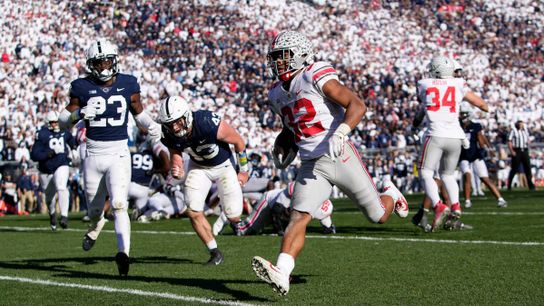No. 11 Penn State's 27-26 loss to No. 3 Ohio State loss was a Herb Brooks game for everyone wearing blue in State College on Saturday -- a game that, as the 1980 U.S. Olympic hockey coach warned his team, they will take with them to their "f'ing graves."
Before the largest crowd to ever see a game at Beaver Stadium, Penn State shot out to a 13-0 lead, blew it, re-claimed the bulk of that lead at 26-14 with eight minutes to go, then blew that lead. Even still, the Nittany Lions were in good shape. After Ohio State's go-ahead touchdown, Penn State got the ball back with 2:02 to play and a full compliment of timeouts, needing only a field goal to take a third (and presumably final) lead.
More than that, they had a quarterback who was playing out of his mind. Trace McSorley was in the process of setting a single-game program record with 461 yards of total offense -- 286 passing, a modern-day Penn State record 175 rushing -- and two touchdowns. Outside of McSorley keepers, though, Penn State struggled to run the ball. Even without future first-round pick Nick Bosa, Ohio State still had one of the best defensive lines in college football, and spent most of the night bottling up Lions running back Miles Sanders. Sanders had averaged 7.8 yards per carry in Penn State's three previous games, but Ohio State held him under 3.
Okay, back to the drive. After a touchback, McSorley immediately moved Penn State into Ohio State territory, hitting Pat Freiermuth for a 27-yard gain. On a 1st-and-10 from the Ohio State 48-yard line, Buckeye defensive end Chase Young broke through and sacked McSorley for a 4-yard loss. On 2nd-and-14, McSorley threw incomplete. Clearly in four-down territory, McSorley kept on 3rd-and-14 for a 9-yard gain, setting up a makable yet difficult 4th-and-5 from the Ohio State 43 with 1:22 to go.
Facing the play of the game, play of the season, Penn State called timeout to talk it over.
Then Ohio State called timeout.
Then Penn State called timeout again.
After those three timeouts, McSorley went to the line and checked with the sideline on three separate occasions. First, he shifted from a pistol formation to the shotgun with Sanders to his right. Then, just before the snap he shifted Sanders to his left.
And after all that buildup -- dating all the way back to Penn State's heart-stomping, lead-blowing, season-defining 39-38 loss in Columbus last season -- the Play of the Year was over as soon as it started.
Penn State attempted to run a zone read, and Ohio State forced the ball out of McSorley's hands. Dre'Mont Jones busted the play from the inside, and Young twisted from his spot on the left end straight into Sanders's lap.
Penn State offensive coordinator Ricky Rahne spoke with the Associated Press Monday, blaming himself for "a particular thing" he should have seen from the Ohio State front that would have led him to choose another play, though he declined to specify what that thing was.
Still, Rahne chose the play because Greg Schiano showed a pass-rushing front, one that Rahne successfully countered with a 12-yard Sanders run on a 3rd-and-13 earlier in the game.
"So that was the thought process that went into it," said Rahne said. "I felt like we had a good chance to run the ball and split it right up the hash. I went back and watched the tape. Is there a possibility for that? Yeah, maybe, but ultimately I didn't give our guys the best chance to succeed."
Franklin took ultimate blame for the play-call, though he didn't second guess his decision not to overrule Rahne and force a different play call.
"A guy is into the flow of calling the game and you try to jump in and call something, I don't think that's in the best interest of our players and our organization," Franklin said. "When the head coach jumps in and tries to change the call that can do more harm than good in the long-term."
